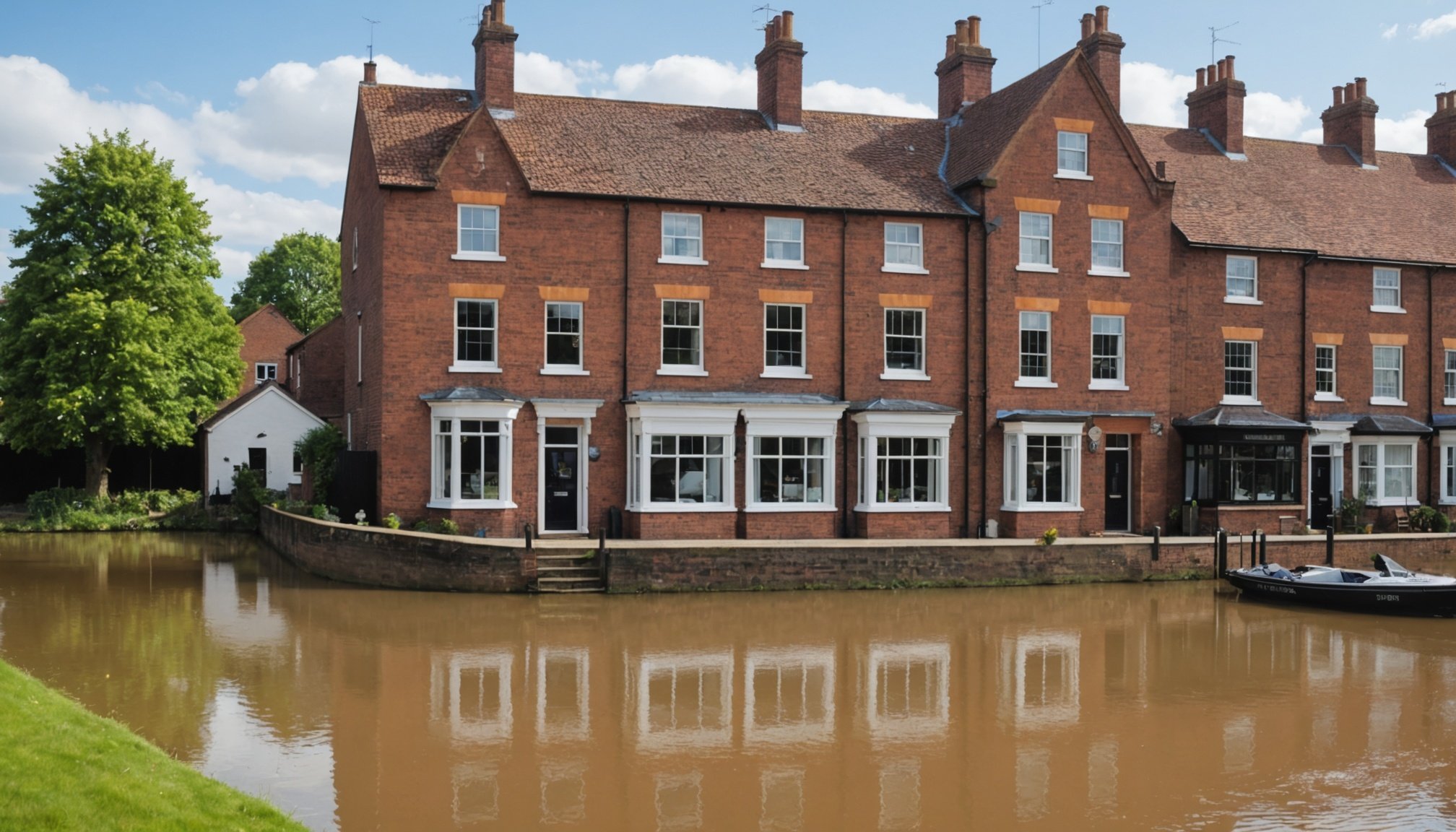Understanding Flood Risk in York
The flood risk assessment is crucial when considering buying a home in York. It involves evaluating the likelihood of a property being affected by flooding due to natural or artificial changes in rivers, land, or drainage systems. This is particularly significant because it influences not only personal safety but also insurance premiums and property value.
York has a notable flood history, with significant flood incidents impacting its neighborhoods over the years. For instance, the 2015 floods were devastating, affecting thousands of properties and prompting numerous residents to reconsider the safety of their homes. These events underline the need for comprehensive assessments and preparedness.
A découvrir également : Exploring the Influence of University Proximity on Rental Demand in Cambridge: A Comprehensive Analysis
For those thinking of buying a home in York, awareness of the area’s flood history is imperative. Prospective buyers should prioritize this knowledge as it aids in making informed decisions. Understanding past flooding impacts can guide decisions on property investments, ensuring potential homeowners avoid areas with high, persistent flood risks.
A detailed flood risk assessment will consider factors such as topography, drainage systems, and historical flood patterns. This can significantly aid homebuyers in choosing locations with lower risks, protecting their investment and ensuring overall resilience against York’s flood challenges.
En parallèle : Unveiling the Risks: Navigating Property Auctions in Coventry
Local Flood History and Data
Understanding the history and current status of flooding in York is essential for residents and potential home buyers. This section delves into historical flooding events and presents critical flood statistics that highlight the region’s vulnerability.
Notable Flood Events in York
York has experienced significant historical flooding events that have shaped the city’s landscape and infrastructure. The severe flood of 1947 is often cited, when melting snow combined with heavy rainfall led to widespread inundation. Significant efforts were made to improve flood defences following the disastrous 1982 flood, which saw the River Ouse waters burst their banks, impacting homes and businesses. In 2000, the city faced another extreme event, underlining the ongoing challenge of managing flood risks.
Current Flood Risk Statistics
Current flood statistics reveal that York remains at considerable risk. Estimates indicate that certain areas have a one in five chance of experiencing property flooding annually. These foreboding numbers are significant for anyone considering property investments in York, underscoring the need for adequate insurance and robust flood protection measures.
Analyzing Long-term Trends
Evaluating long-term trends provides valuable insights into York’s evolving flood risk landscape. Over the past century, data suggests an increase in both the frequency and intensity of flooding events. Climate change and urban development continue to influence these patterns, necessitating proactive measures to mitigate future risks.
Government Resources and Support
Flood management remains a critical focus for local authorities in York, especially in areas identified as flood zones. Residents need access to useful tools and information offered by government flood resources. Local government agencies play a pivotal role in managing flood risk and providing emergency assistance. They facilitate flood risk management through coordinated efforts, including the dissemination of flood zone maps. These maps are vital as they indicate areas prone to flooding, helping homeowners better understand their specific risks.
To obtain these maps, residents can typically visit their local government office or website, providing an easy way to gauge their property’s vulnerability. In addition to the maps, local agencies provide regulatory guidelines to ensure homeowners are informed and compliant. These guidelines often include the requirement for flood risk disclosures when buying or selling property. It’s crucial for homeowners to familiarize themselves with these rules to reduce surprises during property exchanges and enhance the safety of their investments.
Proactively utilizing government resources empowers residents to make informed decisions and implement protective measures, significantly mitigating potential flood-related damages.
Insurance Considerations for Flood Risk
When evaluating flood risk, understanding the insurance landscape is crucial to protecting your property. Homeowners insurance typically does not cover flood damage, leaving a gap that needs addressing with dedicated flood insurance.
Types of Flood Insurance Policies
Flood insurance policies are primarily offered through the National Flood Insurance Program (NFIP) and private insurers. NFIP policies are standardised and backed by the government, while private policies offer more customisable options. Choose based on your risk evaluation and specific needs.
Coverage Options and Limitations
Flood insurance can cover both the building and its contents; however, limitations often apply. While NFIP provides baseline coverage, it may exclude essential areas such as basements and detached structures. Private insurers might offer broader coverage but usually come at a higher cost. Understanding these limitations is crucial in selecting the right policy.
Importance of Flood Insurance in York
York, prone to flooding events, underscores the necessity for flood insurance for homeowners. A well-chosen policy protects not just property, but also offers peace of mind in the face of potential risk evaluation. For residents in high-risk areas, insurance serves as a financial safeguard against devastating losses.
Evaluating Flood Zone Maps and Their Importance
Understanding flood zone maps is crucial, especially for those considering home buying in York. These maps provide vital information about areas susceptible to flooding. To effectively read and interpret these maps, look for zones classified by letters and numbers representing different flood risk levels. Typically, Zones A or V indicate higher flood risk compared to Zone X, which may suggest a minimal risk for flooding.
Several mapping tools are available to aid in assessing these zones. Government agencies often provide online resources where you can input an address to view its flood zone classification. These tools use historical data and projections to offer a comprehensive view of flood risks. Interactive maps can also show how specific geographic features, like rivers or valleys, impact flooding potential.
Flood zone classification directly influences home buying decisions. Properties in high-risk areas may require additional insurance, affecting overall affordability. Prospective buyers in York should thoroughly review flood zone maps, as well as insurance requirements. Understanding the impact on property value and safety remains critical. Hence, by using these mapping tools, buyers can make informed decisions, avoiding unwanted surprises.
Expert Advice on Flood Risk Assessment
Navigating the complexities of flood risk evaluation can be daunting. It is advisable to seek professional support to ensure comprehensive assessments. Understanding the nuances of flood assessments and obtaining sound real estate advice are pivotal in safeguarding your property investment.
Hiring Professionals for Flood Risk Assessment
When considering professionals for flood risk assessments, ensure they have extensive experience in your geographical area. Qualified experts utilise advanced tools and methodologies to accurately evaluate potential flood threats. This precision can save you time and cost in the long run. Experts come equipped with knowledge of historical flood data and local environmental factors that inform their evaluations, making their input invaluable for informed decision-making.
Key Questions to Ask Real Estate Agents
It’s vital to ask real estate agents targeted questions about flood risks when viewing potential properties. Inquire about the property’s flood history, existing mitigation measures, and insurance implications. These questions help clarify any uncertainties and strengthen your understanding of the potential risks. Additionally, request expert flood assessments from real estate professionals before commitment.
Utilizing Local Expertise
Local experts possess an intricate understanding of area-specific flood patterns and can offer bespoke real estate advice. Their firsthand knowledge is crucial for accurate flood assessments. Engaging with community specialists can provide a clearer, nuanced perspective of flood risks, enhancing your decision-making process.
Practical Tips for Prospective Home Buyers
When considering properties in flood-prone areas, there are several home buying tips that can help. Firstly, assess the property’s flood history and location-related risks. Consult with local authorities for flood maps and inquire about past flood events. Flood preparedness is key, so look for signs of previous water damage within the home. Evaluate the elevation and drainage systems around the property.
Implementing safety measures is crucial. Consider the installation of flood barriers and sump pumps. Inspect the foundation for vulnerabilities and ensure that electrical systems are positioned above the flood level. Invest in resilient landscaping; this can mitigate water flow and reduce potential damage.
For ongoing flood preparedness, homeowners should familiarize themselves with available resources. Access online platforms that provide real-time flood alerts. Enroll in community programs focusing on flood risk management. Additionally, maintain an emergency supply kit and establish a family evacuation plan. Regularly review and update insurance coverage specific to flooding.
These strategies not only offer protection but can also provide peace of mind. By equipping oneself with the right knowledge and tools, potential risks are minimized, ensuring a safer home environment.











